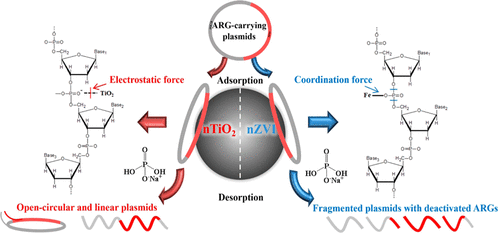当前位置:
X-MOL 学术
›
Environ. Sci. Technol.
›
论文详情
Our official English website, www.x-mol.net, welcomes your
feedback! (Note: you will need to create a separate account there.)
Binding Force and Site-Determined Desorption and Fragmentation of Antibiotic Resistance Genes from Metallic Nanomaterials
Environmental Science & Technology ( IF 10.8 ) Pub Date : 2021-06-17 , DOI: 10.1021/acs.est.1c02047 Xinye Lu 1 , Jie Hou 1 , Kun Yang 1, 2 , Lizhong Zhu 1, 2 , Baoshan Xing 3 , Daohui Lin 1, 2, 4
Environmental Science & Technology ( IF 10.8 ) Pub Date : 2021-06-17 , DOI: 10.1021/acs.est.1c02047 Xinye Lu 1 , Jie Hou 1 , Kun Yang 1, 2 , Lizhong Zhu 1, 2 , Baoshan Xing 3 , Daohui Lin 1, 2, 4
Affiliation

|
Interfacial interactions between antibiotic resistance genes (ARGs) and metallic nanomaterials (NMs) lead to adsorption and fragmentation of ARGs, which can provide new avenues for selecting NMs to control ARGs. This study compared the adsorptive interactions of ARGs (tetM-carrying plasmids) with two metallic NMs (ca. 20 nm), i.e., titanium dioxide (nTiO2) and zero-valent iron (nZVI). nZVI had a higher adsorption rate (0.06 min–1) and capacity (4.29 mg/g) for ARGs than nTiO2 (0.05 min–1 and 2.15 mg/g, respectively). No desorption of ARGs from either NMs was observed in the adsorptive background solution, isopropanol or urea solutions, but nZVI- and nTiO2-adsorbed ARGs were effectively desorbed in NaOH and NaH2PO4 solutions, respectively. Molecular dynamics simulation revealed that nTiO2 mainly bound with ARGs through electrostatic attraction, while nZVI bound with PO43– of the ARG phosphate backbones through Fe–O–P coordination. The ARGs desorbed from nTiO2 remained intact, while the desorbed ARGs from nZVI were splintered into small fragments irrelevant to DNA base composition or sequence location. The ARG removal by nZVI remained effective in the presence of PO43–, natural organic matter, or protein at environmentally relevant concentrations and in surface water samples. These findings indicate that nZVI can be a promising nanomaterial to treat ARG pollution.
中文翻译:

金属纳米材料抗生素抗性基因的结合力和定点解吸和断裂
抗生素抗性基因(ARGs)和金属纳米材料(NMs)之间的界面相互作用导致ARGs的吸附和断裂,这可以为选择NMs控制ARGs提供新的途径。该研究比较了 ARG(携带tetM 的质粒)与两种金属 NM(约 20 nm),即二氧化钛 (nTiO 2 ) 和零价铁 (nZVI)的吸附相互作用。nZVI对 ARG 的吸附速率 (0.06 min –1 ) 和容量 (4.29 mg/g) 比 nTiO 2 (分别为 0.05 min –1和 2.15 mg/g) 高。在吸附背景溶液、异丙醇或尿素溶液中未观察到 ARGs 从任一 NMs 解吸,但 nZVI- 和 nTiO 2吸附的 ARG 分别在 NaOH 和 NaH 2 PO 4溶液中有效解吸。分子动力学模拟表明,nTiO 2主要通过静电吸引与 ARG 结合,而 nZVI通过 Fe-O-P 配位与 ARG 磷酸盐骨架的PO 4 3-结合。从 nTiO 2解吸的 ARGs保持完整,而从 nZVI解吸的 ARGs分裂成与 DNA 碱基组成或序列位置无关的小片段。nZVI 去除 ARG 在 PO 4 3-存在下仍然有效、天然有机物质或环境相关浓度和地表水样品中的蛋白质。这些发现表明,nZVI 可能是一种很有前途的纳米材料,可用于治疗 ARG 污染。
更新日期:2021-07-06
中文翻译:

金属纳米材料抗生素抗性基因的结合力和定点解吸和断裂
抗生素抗性基因(ARGs)和金属纳米材料(NMs)之间的界面相互作用导致ARGs的吸附和断裂,这可以为选择NMs控制ARGs提供新的途径。该研究比较了 ARG(携带tetM 的质粒)与两种金属 NM(约 20 nm),即二氧化钛 (nTiO 2 ) 和零价铁 (nZVI)的吸附相互作用。nZVI对 ARG 的吸附速率 (0.06 min –1 ) 和容量 (4.29 mg/g) 比 nTiO 2 (分别为 0.05 min –1和 2.15 mg/g) 高。在吸附背景溶液、异丙醇或尿素溶液中未观察到 ARGs 从任一 NMs 解吸,但 nZVI- 和 nTiO 2吸附的 ARG 分别在 NaOH 和 NaH 2 PO 4溶液中有效解吸。分子动力学模拟表明,nTiO 2主要通过静电吸引与 ARG 结合,而 nZVI通过 Fe-O-P 配位与 ARG 磷酸盐骨架的PO 4 3-结合。从 nTiO 2解吸的 ARGs保持完整,而从 nZVI解吸的 ARGs分裂成与 DNA 碱基组成或序列位置无关的小片段。nZVI 去除 ARG 在 PO 4 3-存在下仍然有效、天然有机物质或环境相关浓度和地表水样品中的蛋白质。这些发现表明,nZVI 可能是一种很有前途的纳米材料,可用于治疗 ARG 污染。











































 京公网安备 11010802027423号
京公网安备 11010802027423号